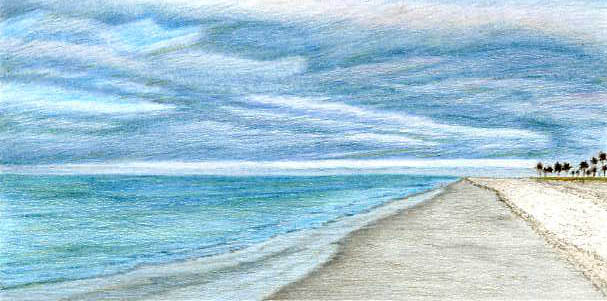In February Tom & I spent a week on Captiva Island, just off the southwest coast of Florida. Each morning at daybreak, after a quick cup of coffee, we pulled on shorts, t-shirts & flip-flops, grabbed our windbreakers, shelling implements (Tom) & cameras (me) & headed to the beach. And each morning, strolling that endless ribbon of sand, looking out across that calm, limpid water, I marveled at how different Captiva looked from all the other beaches I’ve ever visited. And I thought to myself, “When I paint Captiva Island, my subjects will be this sky, this sea & this sand, but I will be telling the story of utter tranquility, of solitude, of infinity.”
Last month’s blog examined how filmmakers use the camera to buttress the plots of their movies. Similarly, sauntering along the water’s edge, I considered how best to use the elements of composition to buttress the plot of my painting: First off, I wanted this painting to not only invite the viewer inside visually, but to also suggest a sense of being enveloped by it. Accomplishing this would require, at the very least, a quite large painting. Moreover, only landscape format (as opposed to portrait format) would lend the requisite feeling of great distances, of space expanding indefinitely.
Because the Gulf water was rather flat & featureless, I decided to create some interest by situating the horizon line a bit low in the painting & filling the sky with a pattern of clouds. The early-morning skies on Captiva were often cloudy but as the sun rose higher, the clouds separated into bands, revealing streaks of blue in between. So, by stretching some cumulus diagonally across the painting from left to right, the viewer’s eyes would be led nicely through it to a group of palm trees in the far distance that I had become enamored of, for no other reason than that they were just so divinely picture postcard-perfect!
Below the horizon line, the sea & land would form 4 different triangles: Open water; a thin skin of broken water; wet, packed sand, & dry, fluffy sand. Each of these shapes would follow the principles of perspective by converging at a single point on the horizon, again leading the viewer’s eyes deep into the painting. To offer that essential, unobstructed visual path directly into the scene, the vantage point of the viewer would be in front of the packed sand, the start of which would correspond to the bottom edge of the painting. One simply steps right in & begins the journey! Finally, the absence of any figures, birds & so forth would complete the sense of peace & solitude.
Here is a preliminary sketch for my painting of an early February morning on Captiva Island with its sand & sea, its clouds & sky, telling the story of infinity:

How very different from the story told by the sand & sea of, say, California’s Big Sur coastline. A case in point: There is a scene in Alfred Hitchcock’s Vertigo where Madeleine (Kim Novak) & Scottie (James Stewart) stand in front of the rocky, wind-swept coastline of Monterey Peninsula & embrace. Their lips meet… & a wave crashes onto the rocks, sending a huge spray of foam into the air & giving form to the intense passion they share. Certainly this is a seascape that offers the viewer nothing in the way of tranquility! Au contraire, it speaks volumes to the strength & turbulence of the ocean. Let’s examine how to paint that story in the next blog.
